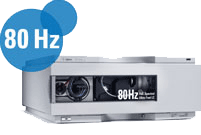|
Instrument Database:
Agilent Technologies Inc. - 1100 Series Diode-array Detector SL
| |
|

|
| |
|
| |
|
| Year of introduction |
|
| Status |
historical ( out of sale ) |
| Company |
Agilent Technologies Inc.
|
| Categories |
Chromatography: LC-Detector: Diode Array
|
|
Ultra-fast LC with the fastest diode-array detector in the world! In 2003 Agilent invented the new field of ultra-fast LC - with peak widths between 0.2 and 1 seconds, analysis times between 0.2 und 2.0 minutes and cycle times (injection-to-injection) between 0.5 and 2.5 minutes.
However, with 20 Hz signal sampling rate and 10 Hz spectral rate, today's diode-array detectors are not fast enough to keep up with the analysis speed of ultra-fast LC. To overcome this limitation and cope with ultra-fast peaks narrower than 1 second Agilent has developed the new 1100 Series diode-array detector SL (DAD SL). The DAD SL offers multiple-wavelength and full spectral detection at up to 80 Hz sampling rate thereby increasing chromatographic resolution by up to 100 %. The DAD SL still enables precise identification, quantification and peak purity analysis - even at trace level when operated at high data rates. This exceptional capability let's your ultra-fast LC methods comply with strictest regulatory performance requirements. Features - 80 Hz data acquisition of up to 8 signals – for up to 100 % resolution gain in ultra-fast LC
- 80 Hz full spectral data acquisition – for ultra-fast, high sensitive peak purity analysis and spectral conformation even at trace levels.
- Improved diode-array front-end electronics – for minimized short-term noise (typical < ± 6µAU ASTM)
- New electronic temperature control (ETC) – for maximum baseline stability and practical sensitivity under fluctuating ambient temperature and humidity conditions.
- New standard flow cell – for increased practical sensitivity by minimized RI-sensitivity and dispersion.
- Broad range of analytical and preparative flow cells for maximum flexibility and investment protection – 5 different analytical flow cells with 13 µL, 5 µL, 1.7 µL, 500 nl and 80 nl volume and 3 preparative flow cells with 3 mm, 0.3 mm and 0.06 mm ensure detector compatibility not only with ultra-fast LC but, also with conventional LC on 5-µm standard and narrow bore columns, capillary LC, nanoflow LC and preparative LC. All flow cells are equipped with RFID-tags.
- New RFID tags for all flow cells and UV lamp – Radio frequency identification (RFID) tags for all flow cells and the UV lamp provides a new level of data traceability. The RFID tags record parameters like product and serial number, production date, cell dimensions, lamp usage, and the last date of a successful cell or lamp test. Each individual raw data file includes all this information for unambiguous data traceability thereby minimizing the risk of false data interpretation.
- New built-in data recovery card – A unique data recovery functionality prevents data losses in case of communication breakdowns between instrument and PC. This "data never lost" insurance is achieved by automated full-spectral data buffering on an embedded memory card.
- LAN on board – A built-in LAN connection directly interfaces your detector with your local network.
- Future-proof design – Built-in web-server, USB, PCMCIA (future WLAN, Bluetooth, Firewire).
- Proven robustness and performance - the 1100 Series DAD SL builds upon the optical design of the 1100 Series DAD - preserving unique features such as a programmable slit and dual-lamp design for highest sensitivity and spectral quality from 190 to 950 nm.
Typical Performance Even More Detailed Information
A detailed PowerPoint slide presentation is available for even more indepth information on features, benefits and typical performance of the Agilent 1100 Series DAD SL and the Agilent 1100 Series MWD SL.
• View (PDF file, 2 MB)
• Download PowerPoint presentation with speaker notes (6 MB). Use the right mouse click and choose "Save Target As" to download presentation.
|
Related links:
|